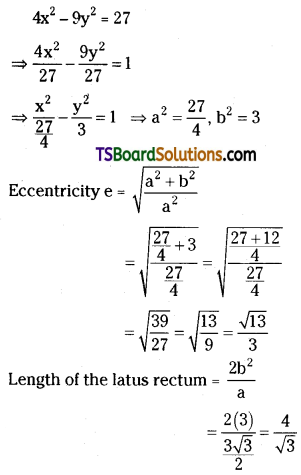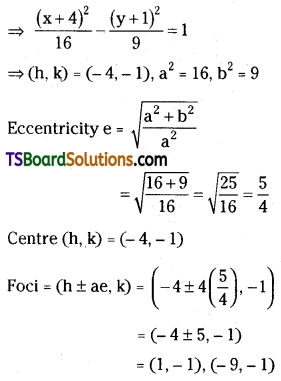Students must practice these Maths 2B Important Questions TS Inter Second Year Maths 2B Ellipse Important Questions to help strengthen their preparations for exams.
TS Inter Second Year Maths 2B Ellipse Important Questions
Question 1.
Find the equation of the ellipse with focus at (1, -1), e = \(\frac{2}{3}\) and directrix as x + y + 2 = 0. [(TS) Mar. ’19; (AP) May ’16]
Solution:
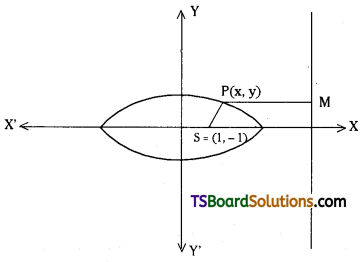
Given that focus S = (1, -1)
Equation of the directrix is x + y + 2 = 0
Eccentricity, e = \(\frac{2}{3}\)
Let P(x, y) be any point on the ellipse.
Since ‘P’ lies on the ellipse then
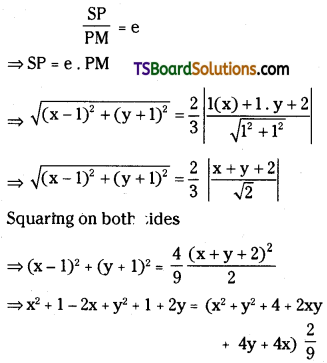
⇒ 9x2 + 9y2 – 18x + 18y + 18 – 2x2 – 2y2 – 4xy – 8x – 8y – 8 = 0
⇒ 7x2 – 4xy + 7y2 – 26x + 10y + 10 = 0
∴ The equation of the ellipse is 7x2 + 7y2 – 4xy – 26x + 10y + 10 = 0
Question 2.
Find the equation of the ellipse in the standard form such that the distance between the foci is 8 and the distance between the directrices is 32. [(AP) May ’17]
Solution:
Let the equation of the ellipse is
\(\frac{x^2}{a^2}+\frac{y^2}{b^2}\) = 1 (a > b) ………(1)
Given that the distance between the foci = 8
2ae = 8
ae = 4 ……(2)
The distance between directrices = 32
\(\frac{2a}{e}\) = 32
\(\frac{a}{e}\) = 16 ……….(3)
Now (2) × (3)
ae . \(\frac{a}{e}\) = 4 . 16
⇒ a2 = 64
⇒ a = 8
We know that b2 = a2(1 – e2)
⇒ b2 = a2 – a2e2
⇒ b2 = (8)2 – (4)2
⇒ b2 = 64 – 16
⇒ b2 = 48
∴ The equation of the ellipse is \(\frac{x^2}{64}+\frac{y^2}{48}=1\)

Question 3.
Find the equation of the ellipse in the standard form whose distance between foci is ‘2’ and the length of the latus rectum is \(\frac{15}{2}\). [(AP) Mar. ’18; (TS) ’15]
Solution:
Let the equation of the ellipse is
\(\frac{x^2}{a^2}+\frac{y^2}{b^2}=1\) (a > b) ……..(1)
Given that distance between foci = 2
⇒ 2ae = 2
⇒ ae = 1
Length of latus rectum = \(\frac{15}{2}\)
∴ \(\frac{2 b^2}{a}=\frac{15}{2}\)
b2 = \(\frac{15a}{4}\)
We know that b2 = a2(1 – e2)
⇒ b2 = a2 – a2e2
⇒ \(\frac{15a}{4}\) = a2 – (1)
⇒ 15a = 4a2 – 4
⇒ 4a2 – 15a – 4 = 0
⇒ 4a2 – 16a + a – 4 = 0
⇒ 4a(a – 4) + 1(a – 4) = 0
⇒ (a – 4) (4a + 1) = 0
⇒ a = 4, a = \(\frac{-1}{4}\)
Since ‘a’ is always positive then a = 4
If a = 4, then b2 = \(\frac{15(4)}{4}\) = 15
∴ The equation of the ellipse is \(\frac{x^2}{16}+\frac{y^2}{15}=1\)
Question 4.
Find the equation of the ellipse referred to its major and minor axes as the coordinate axes X, Y respectively with latus rectum of length 4, and distance between foci 4√2. [May & Mar. ’19 (AP); Mar. ’18 (TS)]
Solution:
Let the equation of ellipse be
\(\frac{x^2}{a^2}+\frac{y^2}{b^2}=1\) (a > b)
by given data length of the latus rectum is
\(\frac{2 \mathrm{~b}^2}{\mathrm{a}}\) = 4
⇒ b2 = 2a ……..(1)
distance between foci is
2ae = 4√2
⇒ ae = 2√2
⇒ a2e2 = 8 …….(2)
Now (1) ⇒ a2(1 – e2) = 2a
⇒ a2 – a2e2 = 2a
⇒ a2 – 8 = 2a
⇒ a2 – 2a – 8 = 0
⇒ a2 – 4a + 2a – 8 = 0
⇒ a(a – 4) + 2(a – 4) = 0
⇒ (a – 4) (a + 2) = 0
⇒ a = -2, 4
Since a ≠ -2 ⇒ a = 4 and
b2 = 2a = 2(4) = 8
∴ Required ellipse be \(\frac{x^2}{16}+\frac{y^2}{8}=1\)
Question 5.
Find the length of the major axis, minor axis, latus rectum, eccentricity, coordinates of centre, foci, and the equations of directrices of the ellipse 9x2 + 16y2 = 144. [(TS) Mar. ’20, ’16; May ’19, ’17; (AP) Mar. ’17, ’15, ’14]
Solution:
Given the equation of the ellipse is 9x2 + 16y2 = 144
⇒ \(\frac{x^2}{16}+\frac{y^2}{9}=1\)
Comparing with \(\frac{x^2}{a^2}+\frac{y^2}{b^2}=1\)
we get a = 4, b = 3 (a > b)
The length of the major axis = 2a = 2(4) = 8
The length of the minor axis = 2b = 2(3) = 6
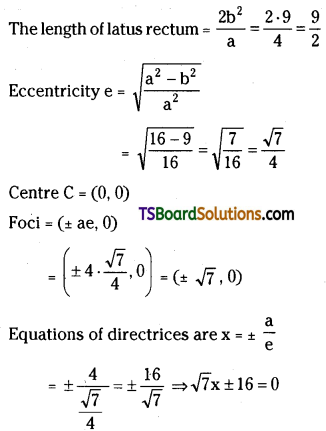
Question 6.
Find the radius of the circle passing through the foci of an ellipse 9x2 + 16y2 = 144 and having the least radius.
Solution:
Given ellipse is 9x2 + 16y2 = 144
⇒ \(\frac{x^2}{16}+\frac{y^2}{9}=1\)
Here a2 = 16 ⇒ a = 4
b2 = 9 ⇒ b = 3
Eccentricity e = \(\sqrt{\frac{a^2-b^2}{a^2}}=\sqrt{\frac{16-9}{16}}=\frac{\sqrt{7}}{4}\)
SS’ = Diameter of the circle = 2ae
⇒ Diameter of the circle = 2√7
⇒ 2r = 2√7
⇒ r = √7
i.e., Radius of the circle CS = √7

Question 7.
The distance of a point on the ellipse x2 + 3y2 = 6 from its centre is equal to 2. Find the eccentric angles.
Solution:
Given the equation of the ellipse is x2 + 3y2 = 6
⇒ \(\frac{x^2}{6}+\frac{3 y^2}{6}=1\)
⇒ \(\frac{x^2}{6}+\frac{y^2}{2}=1\)
a = √6, b = √2, a > b
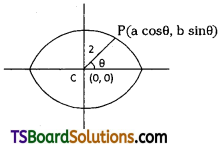
Let P(a cos θ, b sin θ) = (√6 cos θ, √2 sin θ] be a point on the ellipse.
Centre C = (0, 0)
Given that CP = 2
⇒ CP2 = 4
⇒ (√6 cos θ)2 +(√2 sin θ)2 = 4
⇒ 6 cos2θ + 2 sin2θ = 4
⇒ 4 cos2θ + 2 cos2θ + 2 sin2θ = 4
⇒ 4 cos2θ + 2(cos2θ + sin2θ) = 4
⇒ 4 cos2θ + 2 = 4
⇒ 4cos2θ = 2
⇒ cos2θ = \(\frac{1}{2}\)
⇒ cos θ = \(\pm \frac{1}{\sqrt{2}}\)
If cos θ = \(\frac{1}{\sqrt{2}}\) ⇒ θ = \(\frac{\pi}{4}, \frac{7 \pi}{4}\)
If cos θ = \(\frac{-1}{\sqrt{2}}\) ⇒ θ = \(\frac{3\pi}{4}, \frac{5 \pi}{4}\)
∴ Eccentric angles are θ = \(\frac{\pi}{4}, \frac{3 \pi}{4}, \frac{5 \pi}{4}, \frac{7 \pi}{4}\)
Question 8.
Show that the condition for a straight line y = mx + c may be a tangent to the ellipse \(\frac{\mathbf{x}^2}{\mathbf{a}^2}+\frac{\mathbf{y}^2}{\mathbf{b}^2}\) = 1 is c2 = a2m2 + b2. (May ’06, ’02)
Solution:
Given equation of the ellipse is \(\frac{\mathbf{x}^2}{\mathbf{a}^2}+\frac{\mathbf{y}^2}{\mathbf{b}^2}\) = 1
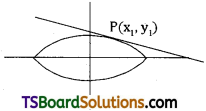
Suppose y = mx + c ……….(1)
is a tangent to the ellipse \(\frac{x^2}{a^2}+\frac{y^2}{b^2}=1\)
Let P(x1, y1) be the point of contact.
The equation of the tangent at ‘P’ is S1 = 0
⇒ \(\frac{\mathrm{xx}_1}{\mathrm{a}^2}+\frac{\mathrm{y} \mathrm{y}_1}{\mathrm{~b}^2}-1=0\) ……..(2)
Now, (1) & (2) represent the same line.
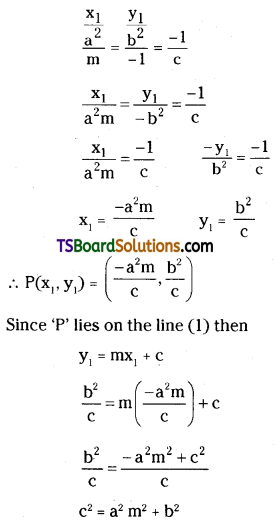
Question 9.
Find the equation of the tangents to 9x2 + 16y2 = 144, which makes equal intercepts on the coordinate axes. [(TS) May ’15]
Solution:
Given the equation of the ellipse is 9x2 + 16y2 = 144
⇒ \(\frac{x^2}{16}+\frac{y^2}{9}=1\)
Here a = 4, b = 3, a > b
Let the equation of the tangent which makes equal intercepts on co-ordinate axes is
x + y = k ……(1)
⇒ y = -x + k
Comparing with y = mx + c, we get
m = -1, c = k
Since eq (1) is a tangent to the given ellipse then
c2 = a2m2 + b2
⇒ (k)2 = 16(-1)2 + 9
⇒ k2 = 16 + 9
⇒ k2 = 25
⇒ k = ±5
Substitute the value of ‘k’ in eq (1).
∴ The equation of the tangent is x + y = ± 5
⇒ x + y ± 5 = 0

Question 10.
Find the equation of the tangent to the ellipse 2x2 + y2 = 8, which makes an angle π/4 with the x-axis. [(AP) May ’19]
Solution:
Given ellipse is 2x2 + y2 = 8
⇒ \(\frac{x^2}{4}+\frac{y^2}{8}=1\) ……..(1)
Comparing (1) with \(\frac{x^2}{a^2}+\frac{y^2}{b^2}=1\), we get
a2 = 4, b2 = 8
Given that θ = \(\frac{\pi}{4}\)
The slope of the tangent is m = tan θ
= tan \(\frac{\pi}{4}\)
= 1
∴ The equation of the tangent to the given ellipse is
y = mx ± \(\sqrt{a^2 m^2+b^2}\)
⇒ y = 1 . x ± \(\sqrt{4(1)+8}\)
⇒ y = x ± √12
⇒ x – y ± 2√3 = 0
Question 11.
Find the equation of the tangents to the ellipse 2x2 + y2 = 8 which are
(i) parallel to x – 2y – 4 = 0
(ii) perpendicular to x + y + 2 = 0 [(AP) May ’19, ’17; (TS) May ’19, Mar. ’17]
Solution:
Given the equation of the ellipse is 2x2 + y2 = 8
⇒ \(\frac{x^2}{4}+\frac{y^2}{8}=1\)
Here a2 = 4, b2 = 8
(i) Given the equation of the straight line is x – 2y – 4 = 0
The equation of the tangent parallel to the line x – 2y – 4 = 0 is
x – 2y + k = 0 ……..(1)
⇒ 2y = x + k
⇒ y = \(\frac{x}{2}+\frac{k}{2}\)
Comparing with y = mx + c, we get
m = \(\frac{1}{2}\), c = \(\frac{k}{2}\)
Since eq. (1) is a tangent to the given ellipse then

Substitute the value of ‘k’ in eq. (1)
∴ The equation of the tangent is x – 2y ± 6 = 0
(ii) Given the equation of the straight line is x + y + 2 = 0
The equation of the tangent ⊥r to x + y + 2 = 0 is
x – y + k = 0 ………(2)
y = x + k
Comparing with y = mx + c we get
m = 1, c = k
Since eq. (2) is a tangent to the given ellipse then
c2 = a2m2 + b2
⇒ k2 = 4(1)2 + 8
⇒ k2 = 12
⇒ k = ± 2√3
Substitute the value of ‘k’ in eq. (2)
∴ The equation of the tangent is x – y ± 2√3 = 0
Question 12.
Find the equation of tangent and normal to the ellipse 9x2 + 16y2 = 144 at the end of the latus rectum in the 1st quadrant. [(AP) Mar. ’15]
Solution:
Given the equation of the ellipse is 9x2 + 16y2 = 144
⇒ \(\frac{x^2}{16}+\frac{y^2}{9}=1\)
Here a = 4, b = 3, a > b
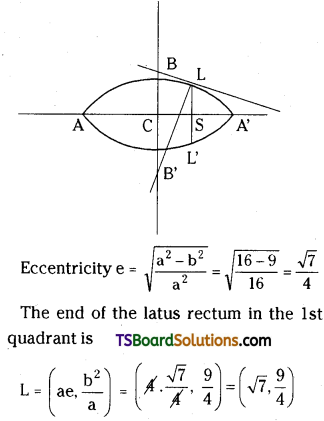
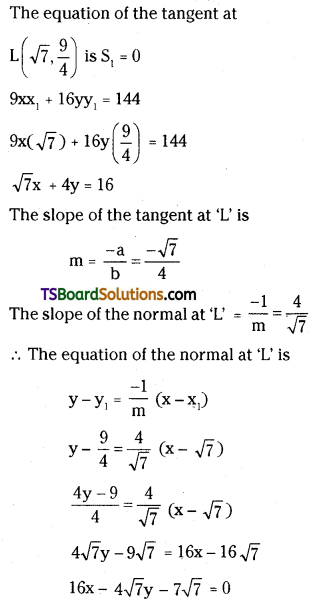
Question 13.
A circle of radius 4, is concentric with the ellipse 3x2 + 13y2 = 78. Prove that the common tangent is inclined to the major axis at angle π/4. [(AP) May ’18]
Solution:
Given the equation of the ellipse is 3x2 + 13y2 = 78
⇒ \(\frac{x^2}{26}+\frac{y^2}{6}=1\)
Here a2 = 26, b2 = 6, a > b
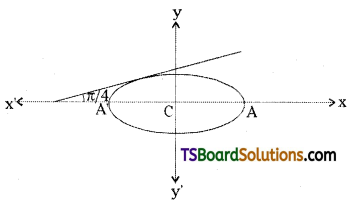
Centre of the ellipse C = (0, 0)
Centre of the circle C = (0, 0) (concentric)
given that the radius of the circle r = 4
The equation of a circle of radius 4 is concentric with the given ellipse, then
x2 + y2 = (4)2
⇒ x2 + y2 = 16
The equation of a tangent to the given ellipse is y = mx ± \(\sqrt{a^2 m^2+b^2}\)
⇒ y = mx ± \(\sqrt{26 m^2+6}\) ……..(1)
Since (1) is a tangent to the circle x2 + y2 = 16, then r = d

Squaring on both sides
⇒ 16(m2 + 1) = 26m2 + 6
⇒ 16m2 + 16 = 26m2 + 6
⇒ 10m2 – 10 = 0
⇒ 10m2 = 10
⇒ m = 1
Here, m is the slope of the tangent, then
m = tan θ
⇒ 1 = tan θ
⇒ θ = \(\frac{\pi}{4}\)
∴ A common tangent is inclined to the major axis at an angle \(\frac{\pi}{4}\).

Question 14.
If the normal at one end of the latus rectum of the ellipse \(\frac{x^2}{a^2}+\frac{y^2}{b^2}=1\) passes through one end of the minor axis, then show that e4 + e2 = 1. (e is the eccentricity of the ellipse) [(TS) May ’17, ’14]
Solution:

Given equation of the ellipse is \(\frac{x^2}{a^2}+\frac{y^2}{b^2}=1\)
Let ‘L’ be the one end of the latus rectum of \(\frac{x^2}{a^2}+\frac{y^2}{b^2}=1\)
Then the coordinates of L = (ae, \(\frac{b^2}{a}\))
∴ The equation of the normal at ‘L’ is
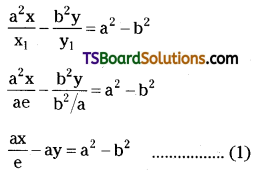
Since eq.(1) passes through one end of the minor axis B'(0, -b) then

Question 15.
The tangent and normal to the ellipse x2 + 4y2 = 4 at a point P(θ) on it meets the major axis in Q and R respectively. If 0 < θ < \(\frac{\pi}{2}\) and QR = 2 then show that θ = cos-1(2/3). [May ’16 (AP) May ’14]
Solution:
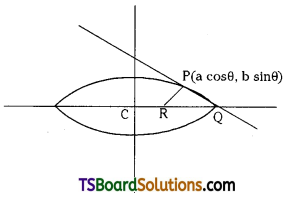
Given the equation of the ellipse is x2 + 4y2 = 4
⇒ \(\frac{x^2}{4}+\frac{y^2}{1}=1\)
Here a = 2, b = 1
Let ‘θ’ be the eccentric angle of ‘P’ then
P(a cos θ, b sin θ) = (2 cos θ, sin θ)
The equation of the tangent at ‘P’ is
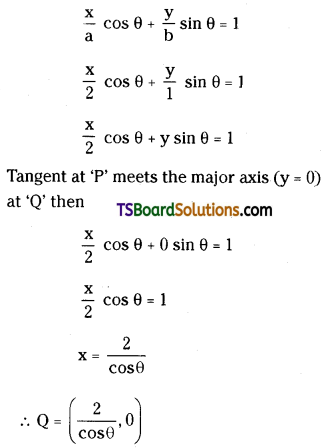

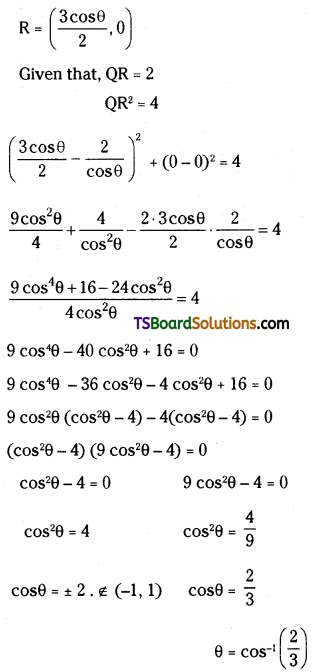
Question 16.
Find the eccentricity, coordinates of foci, length of latus rectum, and equations of directrices of the ellipse 9x2 + 16y2 – 36x + 32y – 92 = 0. [(TS) May & Mar. ’18, ’15]
Solution:
Given equation of the ellipse is 9x2 + 16y2 – 36x + 32y – 92 = 0
⇒ (9x2 – 36x) + (16y2 + 32y) – 92 = 0
⇒ 9(x2 – 4x) + 16(y2 + 2y) – 92 = 0
⇒ 9(x2 – 2 . 2x + 22 – 22) + 16(y2 + 2 . 1 . y + 12 – 12) – 92 = 0
⇒ 9((x – 2)2 – 4) + 16((y + 1)2 – 1) – 92 = 0
⇒ 9(x- 2)2 – 36 + 16(y + 1)2 – 16 – 92 = 0
⇒ 9(x – 2)2 + 16 (y + 1)2 – 144 = 0
⇒ 9(x – 2)2 + 16(y + 1)2 = 144

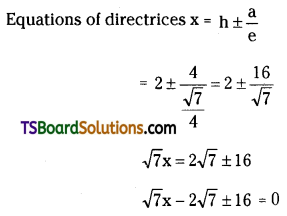
Question 17.
Find the length of the major axis, minor axis, latus rectum, eccentricity, coordinates of centre, foci, and the equations of directrices of the ellipse 4x2 + y2 – 8x + 2y + 1 = 0. [(AP) May ’18]
Solution:
Given equation of the ellipse is 4x2 + y2 – 8x + 2y + 1 = 0
⇒ (4x2 – 8x) + (y2 + 2y) + 1 = 0
⇒ 4(x2 – 2x) + (y2 + 2y) + 1 = 0
⇒ 4((x)2 – 2x . 1 + 12 – 12) + ((y)2 + 2 . y . 1 + 12 – 12) + 1 = 0
⇒ 4((x – 1)2 – 1) + ((y + 1)2 – 1) + 1 = o
⇒ 4(x – 1)2 – 4 + (y + 1)2 – 1 + 1 = 0
⇒ 4(x – 1)2 + (y + 1)2 = 4
⇒ \(\frac{4(x-1)^2}{4}+\frac{(y+1)^2}{4}=1\)
⇒ \(\frac{(x-1)^2}{1}+\frac{(y-(-1))^2}{4}=1\)
Comparing with \(\frac{(\mathrm{x}-\mathrm{h})^2}{\mathrm{a}^2}+\frac{(\mathrm{y}-\mathrm{k})^2}{\mathrm{~b}^2}=1\)
we get h = 1, k = -1, a = 1, b = 2, a < b
The length of the major axis = 2b = 2(2) = 4
The length of the minor axis = 2a = 2(1) = 2
The length of latus rectum = \(\frac{2 a^2}{b}=\frac{2 \cdot 1}{2}\) = 1
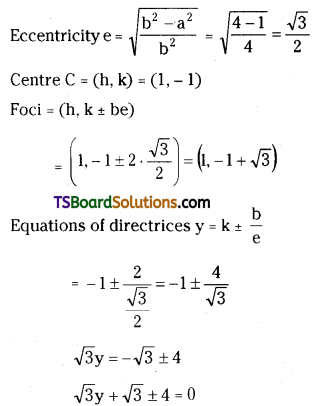
Question 18.
Find the eccentricity, coordinates of foci, length of latus rectum, and equations of directrices of the ellipse 3x2 + y2 – 6x – 2y – 5 = 0. [(AP) May ’15]
Solution:
Given equation of the ellipse is 3x2 + y2 – 6x – 2y – 5 = 0
⇒ (3x2 – 6x) + (y2 – 2y) – 5 = 0
⇒ 3(x2 – 2x) + (y2 – 2y) – 5 = 0
⇒ 3((x)2 – 2 . 1 . x + 12 – 12) + ((y)2 – 2 . 1 . y + 12 – 12) – 5 = 0
⇒ 3((x – 1)2 – 1) + ((y – 1)2 – 1) – 5 = 0
⇒ 3(x – 1)2 – 3 + (y – 1)2 – 1 – 5 = 0
⇒ 3(x – 1)2 + (y – 1)2 – 9 = 0
⇒ 3(x – 1)2 + (y – 1)2 = 9
⇒ \(\frac{(x-1)^2}{9 / 3}+\frac{(y-1)^2}{9}=1\)
⇒ \(\frac{(x-1)^2}{3}+\frac{(y-1)^2}{9}=1\)
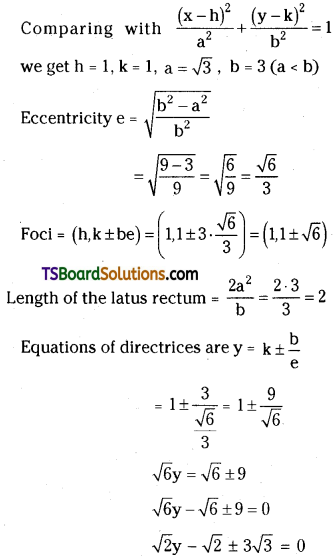
Question 19.
Find the equation of an ellipse in the form \(\frac{(x-h)^2}{a^2}+\frac{(y-k)^2}{b^2}=1\), given that centre (0, -3), e = \(\frac{2}{3}\), semi-minor axis 5.
Solution:
The equation of the ellipse is
\(\frac{(x-h)^2}{a^2}+\frac{(y-k)^2}{b^2}=1\) ………(1)
Given that Centre C(h, k) = (0, -3)
Eccentricity e = \(\frac{2}{3}\)
Case (i): If a > b, the length of the semi-minor axis b = 5
We know that b2 = a2(1 – e2)
25 = a2(1 – \(\frac{4}{9}\))
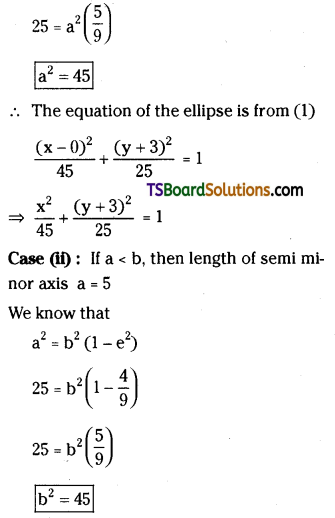
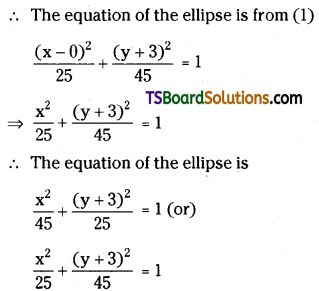

Question 20.
Find the equation of the ellipse in the form \(\frac{(x-h)^2}{a^2}+\frac{(y-k)^2}{b^2}=1\), given that centre (2, -1) one end of the major axis (2, -5), e = \(\frac{1}{3}\).
Solution:
The equation of the ellipse is
\(\frac{(x-h)^2}{a^2}+\frac{(y-k)^2}{b^2}=1\) …….(1)
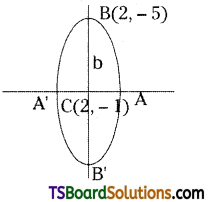
Given that
Centre C(h, k) = (2, -1)
One end of the major axis B = (2, -5)
Eccentricity e = \(\frac{1}{3}\)
In C, B, the x-coordinates are equal, then the major axis is parallel to the y-axis, i.e., a < b
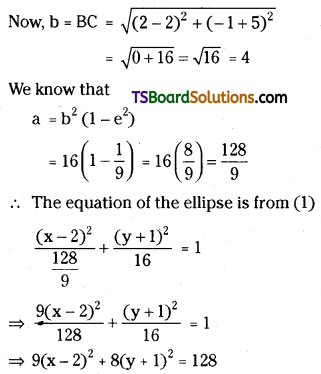
Question 21.
Prove that the equation of the chord joining the points ‘α’ and ‘β’ on the ellipse \(\frac{x^2}{a^2}+\frac{y^2}{b^2}=1\) is \(\frac{x}{a} \cos \left(\frac{\alpha+\beta}{2}\right)+\frac{y}{b} \sin \left(\frac{\alpha+\beta}{2}\right)\) = \(\cos \left(\frac{\alpha-\beta}{2}\right)\) [(TS) May ’16]
Solution:
Given equation of the ellipse is \(\frac{x^2}{a^2}+\frac{y^2}{b^2}=1\)
Given points on the ellipse is P(a cos α, b sin α), Q(a cos β, b sin β)
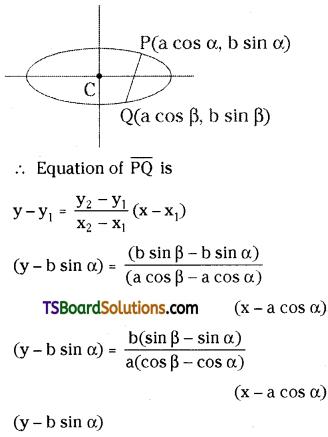

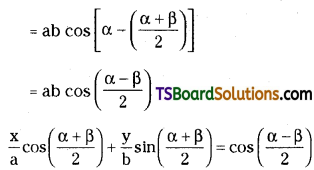
Question 22.
Show that the foot of the perpendicular drawn from centre to any tangent to the ellipse lies on the curve (x2 + y2) = a2x2 + b2y2.
Solution:
Let, the equation of the ellipse is
\(\frac{x^2}{a^2}+\frac{y^2}{b^2}=1\) (a > b)
Let, P(x1, y1) be the foot of the perpendicular drawn from the centre on any tangent to the ellipse.
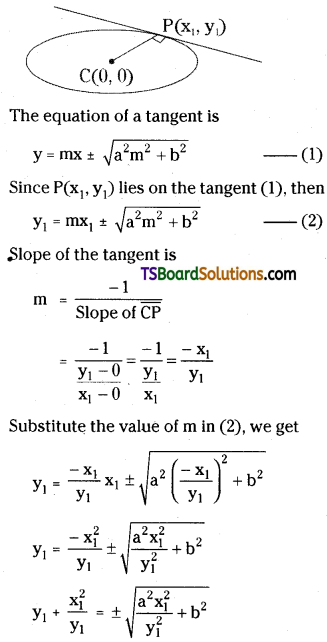
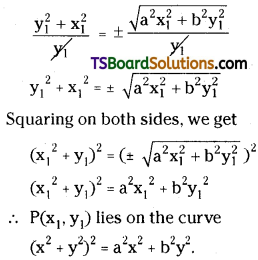
Question 23.
Show that the point of intersection of the perpendicular tangent to an ellipse lies on a circle. [(AP) Mar. ’16]
Solution:

Let the equation of the ellipse be
S = \(\frac{x^2}{a^2}+\frac{y^2}{b^2}-1\) = 0
Let P(x1, y1) be the point of intersection of ⊥r tangent drawn to the ellipse.
Let y = mx ± \(\sqrt{a^2 m^2+b^2}\) be a tangent to the ellipse S = 0 passing through ‘P’, then
y1 = mx1 ± \(\sqrt{a^2 m^2+b^2}\)
y1 – mx1 = ± \(\sqrt{a^2 m^2+b^2}\)
Squaring on both sides,

If m1, m2 are the slopes of the tangents through ‘P’ then m1, m2 are the roots of (1).
Since the tangents through ‘P’ are ⊥r then
m1m2 = -1
⇒ \(\frac{y_1^2-b^2}{x_1^2-a^2}=-1\)
⇒ \(y_1^2-b^2=-x_1^2+a^2\)
⇒ \(\mathrm{x}_1^2+\mathrm{y}_1^2=\mathrm{a}^2+\mathrm{b}^2\)
∴ P lies on x2 + y2 = a2 + b2 which is the circle with centre as the origin, the centre of the ellipse.
Question 24.
Show that the locus of the feet of the perpendiculars drawn from foci to any tangent of the ellipse is the auxiliary circle. [(AP) Mar. ’19, ’17]
Solution:
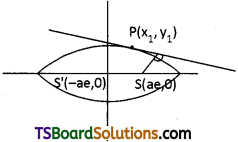
Let the equation of the ellipse be
S = \(\frac{x^2}{a^2}+\frac{y^2}{b^2}-1\) = 0
Let P(x1, y1) be the foot of the ⊥r drawn from either of the foci to a tangent.
The equation of the tangent to the ellipse S = 0 is
y = mx ± \(\sqrt{a^2 m^2+b^2}\) ……..(1)
The equation to the perpendicular from either focus (±ae, 0) on this tangent is

∴ ‘P’ lies on x2 + y2 = a2 which is a circle with centre as the origin, the centre of the ellipse.

Question 25.
Prove that the equation of an ellipse in the standard form is \(\frac{x^2}{a^2}+\frac{y^2}{b^2}=1\). (Mar. ’95)
Solution:
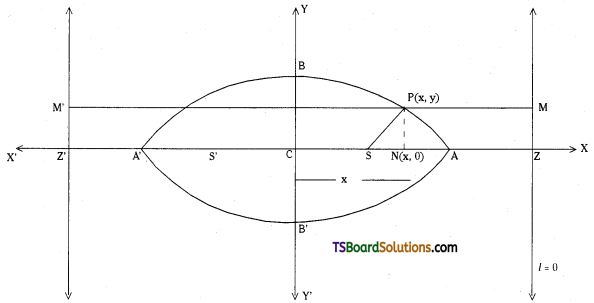
Let ‘S’ be the focus, ‘e’ be the eccentricity and l = 0 be the directrix of the ellipse.
Let ‘P’ be a point on the ellipse.
Let M, Z be the projections (foot of the ⊥rs) of P, S on the directrix L = 0 respectively.
Let ‘M’ be the projection of ‘P’ on ‘SZ’.
Since e < 1 we can divide SZ both internally and externally in the ratio e : 1.
Let A, A’ be the points of division of SZ in the ratio e : 1 internally and externally respectively.
Let AA’ = 2a
Let ‘C’ be the midpoint of AA’.
Points A, A’ lies on the ellipse and \(\frac{\mathrm{SA}}{\mathrm{AZ}}=\frac{\mathrm{SA}^{\prime}}{\mathrm{ZA}^{\prime}}=\frac{\mathrm{e}}{1}\)
Now \(\frac{S A}{A Z}=\frac{e}{1}\)
⇒ SA = e AZ
⇒ CA – CS = e (CZ – CA) ……..(1)
Also \(\frac{\mathrm{SA}^{\prime}}{\mathrm{ZA}^{\prime}}=\frac{\mathrm{e}}{1}\)
⇒ SA’ = e ZA’
CS + CA’ = e (CA’ + CZ) ……..(2)
Now (1) + (2)
⇒ CA – CS + CS + CA’ = e (CZ – CA) + e(CZ + CA’)
⇒ CA + CA’ = e (CZ – CA) + e (CZ + CA’)
⇒ CA + CA’ = e (2CZ – CA + CA’)
Since ‘C’ is the midpoint of AA’ then CA = CA’
CA + CA = e (2CZ – CA + CA)
⇒ 2CA = 2e CZ
⇒ CA = e CZ
⇒ a = e CZ
⇒ CZ = \(\frac{a}{e}\)
∴ Equation of the directrix is x = \(\frac{a}{e}\)
(1) – (2)
⇒ CA – CS – CS + CA’ = e (CZ – CA) + e(CZ + CZ)
⇒ CA – CS – CS – CA’ = e (CZ – CA – CA – CZ)
⇒ CA – 2CS – CA’ = e(-CA – CA’)
Since ‘C’ is the midpoint at AA’ then CA = CA’
CA – 2CS – CA = e(-CA – CA)
⇒ -2CS = e(-2CA)
⇒ CS = e CA
⇒ CS = eQ
∴ Co-ordinates of focus ‘S’ are (ae, 0)
Take CS, the principal axis of the ellipse as the X-axis, and QS ⊥r to the CX as Y-axis then S = (ae, 0) and the ellipse is in standard form.
Let P = (x, y)
Now PM = NZ = CZ – CN = \(\frac{a}{e}\) – x
‘P’ lies on the ellipse then \(\frac{SP}{PM}\) = e
SP = e . PM
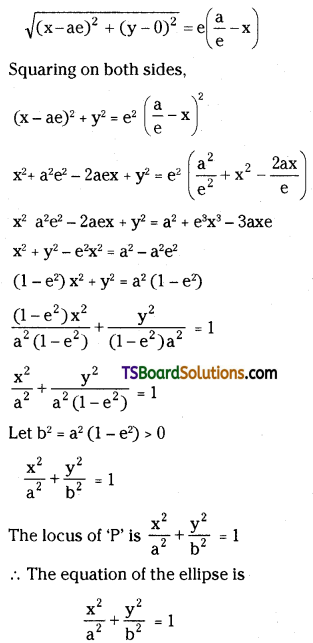
Question 26.
If the length of the latus rectum is equal to half of its minor axis of an ellipse in the standard form, then find the eccentricity of the ellipse. (May, Mar. ’10)
Solution:
Let the equation of the ellipse is \(\frac{x^2}{a^2}+\frac{y^2}{b^2}=1\) (a > b)
The length of the latus rectum = \(\frac{2 b^2}{a}\)
Length of minor axis = 2b
Given that the length of the latus rectum is equal to half of its minor axis then
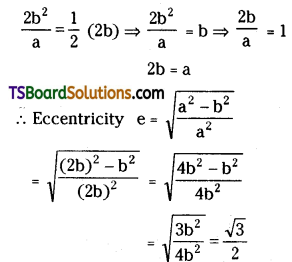
Question 27.
Find the eccentricity of the ellipse (in the standard form), if the length of the latus rectum is equal to half of its major axis.
Solution:
Let the equation of the ellipse is
\(\frac{x^2}{a^2}+\frac{y^2}{b^2}=1\) (a > b)
The length of the latus rectum = \(\frac{2 b^2}{a}\)
Length of the major axis = 2a
Given that the length of the latus rectum is equal to half of its major axis then
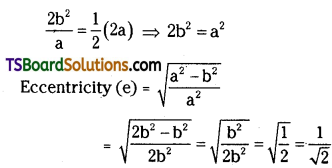
Question 28.
Find the equation of tangent and normal to the ellipse x2 + 8y2 = 33 at (-1, 2). [(TS) Mar. ’20; May ’16]
Solution:
Given the equation of the ellipse is x2 + 8y2 = 33
Let the given point P(x1, y1) = (-1, 2)
The equation of the tangent at ‘P’ is S1 = 0
⇒ xx1 + 8yy1 = 33
⇒ x(-1) + 8y(2) = 33
⇒ -x + 16y = 33
⇒ x – 16y + 33 = 0
Slope of the tangent at P’ is m = \(\frac{-1}{-16}=\frac{1}{16}\)
Slope of the normal at ‘P’ = \(\frac{-1}{m}=\frac{-1}{\frac{1}{16}}\) = -16
The equation of the normal at ‘P’ is
y – y1 = \(\frac{-1}{m}\)(x – x1)
⇒ y – 2 = -16(x + 1)
⇒ y – 2 = -16x – 16
⇒ 16x + y + 14 = 0

Question 29.
Find the value of ‘k’ if 4x + y + k = 0 is tangent to the ellipse x2 + 3y2 = 3.
Solution:
Given the equation of the ellipse is x2 + 3y2 = 3
⇒ \(\frac{x^2}{3}+\frac{y^2}{1}=1\)
Here a2 = 3, b2 = 1
Given the equation of the straight line is
4x + y + k = 0 ……..(1)
y = -4x – k
Comparing with y = mx + c we get
m = -4, c = -k
Since eq. (1) is a tangent to the given ellipse then c2 = a2m2 + b2
⇒ (-k)2 = 3(-4)2 + 1
⇒ k2 = 49
⇒ k = ±7
Question 30.
Find the condition for the line x cos α + y sin α = p to be a tangent to the ellipse \(\frac{x^2}{a^2}+\frac{y^2}{b^2}=1\). [(AP) Mar. ’20, ’14]
Solution:
Given equation of the ellipse is \(\frac{x^2}{a^2}+\frac{y^2}{b^2}=1\)
Given the equation of the straight line is x cos α + y sin α = p
y sin α = -x cos α + p
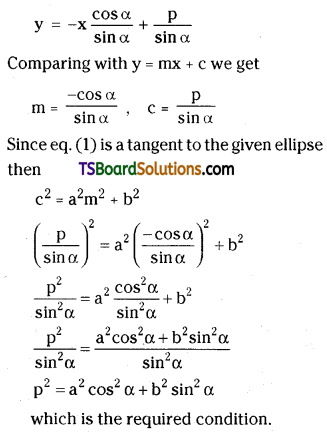
Question 31.
If the length of the major axis of an ellipse is three times the length, of its minor axis, then find the eccentricity of the ellipse.
Solution:
In an ellipse
Length of major axis = 2a
Length of minor axis = 2b
Given that length of the major axis = 2(length of the minor axis)

Question 32.
Find the equation of the auxiliary circle of the ellipse 9x2 + 16y2 = 144.
Solution:
Given ellipse is 9x2 + 16y2 = 144
⇒ \(\frac{x^2}{16}+\frac{y^2}{9}=1\)
Here a2 = 16, b2 = 9 (a > b)
∴ The equation of an auxiliary circle is x2 + y2 = a2
⇒ x2 + y2 = 16
Question 33.
Find the equation of the director circle of the ellipse 9x2 + 25y2 = 225.
Solution:
Given ellipse is 9x2 + 25y2 = 225
⇒ \(\frac{x^2}{25}+\frac{y^2}{9}=1\)
Here a2 = 25, b2 = 9
∴ Equation of director circle is x2 + y2 = a2 + b2
⇒ x2 + y2 = 25 + 9
⇒ x2 + y2 = 34

Question 34.
If P(x, y) is any point on the ellipse \(\frac{x^2}{a^2}+\frac{y^2}{b^2}=1\) (a > b) whose foci are ‘S’ and S’ then show that SP + S’P is a constant. (Mar. ’13, May, Mar. ’93)
Solution:
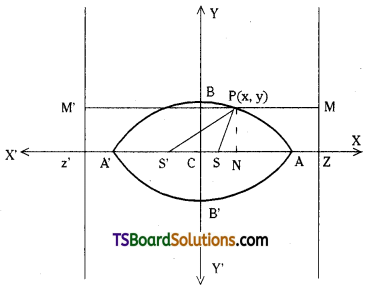
The equation of the ellipse is given as
\(\frac{x^2}{a^2}+\frac{y^2}{b^2}=1\) (a > b)
Let S, S’ be the foci and ZM, Z’M’ be the corresponding directrices.
Join SP and S’P.
Draw PN ⊥r to X-axis and M’MP ⊥r to the two directrices.
By the definition of the ellipse,
\(\frac{\mathrm{SP}}{\mathrm{PM}}\) = e
⇒ SP = e PM
= e NZ
= e (CZ – CN)
= e(\(\frac{a}{e}\) – x)
and \(\frac{\mathrm{S}^{\prime} \mathrm{P}}{\mathrm{PM}^{\prime}}\) = e
S’P = e PM’
= e(NZ’)
= e(CN + CZ’)
= e(x + \(\frac{a}{e}\))
Now SP + S’P
= \(e\left(\frac{a}{e}-x\right)+e\left(x+\frac{a}{e}\right)\)
= a – ex + ex + a
= 2a (constant)
= length of the major axis
Question 35.
The orbit of the Earth is an ellipse with eccentricity \(\frac{1}{60}\) with the sun at one of its foci, the major axis being approximately 186 × 106 miles in length. Find the shortest and longest distance of the earth from the sun.
Solution:
Assume that the orbit of the earth is
\(\frac{x^2}{a^2}+\frac{y^2}{b^2}=1\) (a > b)
Since the major axis is 186 × 106 miles
2a = 186 × 106 miles
∴ a = 93 × 106 miles
If ’e’ be the eccentricity of the orbit, then
e = \(\frac{1}{60}\)
we know that the longest and shortest distances from the earth from the sun are respectively.
a + ae and a – ae.
The longest distance = a + ae
= a(1 + e)
= 93 × 106 (1 + \(\frac{1}{60}\))
= 9455 × 104 miles
The shortest distance = a – ae
= a(1 – e)
= 93 × 106 (1 – \(\frac{1}{60}\))
= 9145 × 104 miles
Question 36.
A man running on a race course notices that the sum of the distances between the two flag posts is always 10 m and the distance between the flag posts is 8m. Find the equation of the race course traced by the man.
Solution:
Let S, S’ be the two flag posts on the x-axis, so that ‘O’ is the midpoint of S, S’.
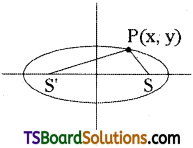
Given that, the distance between the two flag posts = 8
⇒ 2ae = 8
⇒ ae = 4
∴ S(ae, 0) = (4, 0)
S'(-ae, 0) = (-4, 0)
Let P(x, y) be any point on the locus given that,
the sum of the distances of two flag posts = 10
SP + S’P = 10
SP = 10 – S’P
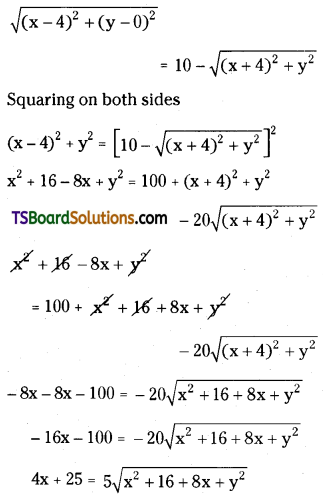
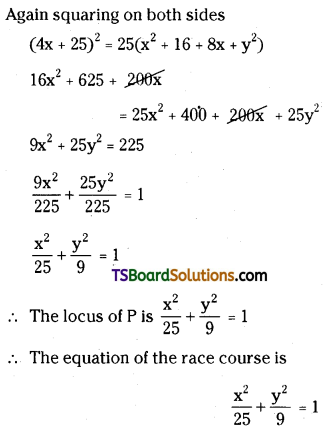
Question 37.
Find the equation of the ellipse in the standard form, if it passes through the points (-2, 2) and (3, -1). [Mar. ’17 (TS)]
Solution:
Let the equation of the ellipse in the standard form is
\(\frac{x^2}{a^2}+\frac{y^2}{b^2}=1\) (a > b) ……(1)
Since equation (1) passes through the point (-2, 2) then
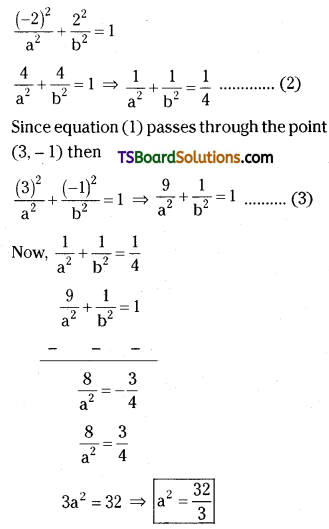
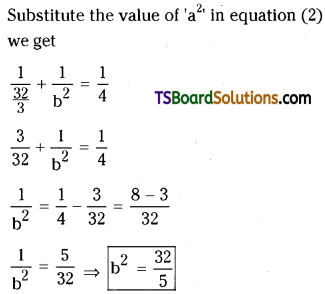
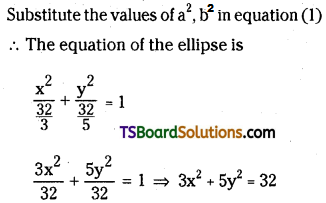

Question 38.
Find the equation of tangent and normal to the ellipse x2 + 2y2 – 4x + 12y + 14 = 0 at (2, -1).
Solution:
Given equation of the ellipse is x2 + 2y2 – 4x + 12y + 14 = 0
Let the given point P(x1, y1) = (2, -1)
The equation of the tangent at ‘P’ is S1 = 0
⇒ xx1 + 2yy1 – 2(x + x1) + 6 (y + y1) + 14 = 0
⇒ x(2) + 2y(-1) – 2(x + 2) + 6(y – 1) + 14 = 0
⇒ 2x – 2y – 2x – 4 + 6y – 6 + 14 = 0
⇒ 4y + 4 = 0
⇒ y + 1 = 0
The slope of the tangent at ‘P’ is m = \(\frac{-0}{1}\) = 0
The slope of the normal at ‘P’ is \(\frac{-1}{\mathrm{~m}}=\frac{-1}{0}\)
∴ The equation of the normal at ‘P’ is
y – y1 = \(\frac{-1}{m}\)(x – x1)
⇒ y + 1 = \(\frac{-1}{0}\) (x – 2)
⇒ 0 = -x + 2
⇒ x – 2 = 0
Question 39.
Find the equations of tangents to the ellipse 2x2 + 3y2 = 11 at the points whose ordinate is 1. [(TS) Mar. ’19, ’16]
Solution:
Given the equation of the ellipse is 2x2 + 3y2 = 11
given that y = 1
2x2 + 3 = 11
⇒ 2x2 = 8
⇒ x2 = 4
⇒ x = ±2
Points of contact P(2, 1) & Q(-2, 1)
Case (i): P(2, 1)
The equation of the tangent is S1 = 0
⇒ 2xx1 + 3yy1 = 11
⇒ 2x(2) + 3y(1) = 11
⇒ 4x + 3y = 11
Case (ii): Q(-2, 1)
The equation of the tangent is S1 = 0
⇒ 2xx1 + 3yy1 = 11
⇒ 2x(-2) + 3y(1) = 11
⇒ -4x + 3y = 11
⇒ 4x – 3y + 11 = 0
Question 40.
Find the equations of the tangents to the ellipse x2 + 2y2 = 3 drawn from the point (1, 2) and also find the angle between them.
Solution:
Given the equation of the ellipse is x2 + 2y2 = 3

Let the given point P(x1, y1) = (1, 2)
The equation of the pair of tangents to the ellipse x2 + 2y2 = 3 drawn from the point P(1, 2) is S . S11 = \(\mathrm{S}_1{ }^2\)
⇒ (x2 + 2y2 – 3) \(\left(x_1{ }^2+2 y_1{ }^2-3\right)\) = (xx1 + 2yy1 – 3)2
⇒ (x2 + 2y2 – 3)[(1)2 + 2(2)2 – 3)] = [x(1) + 2y(2) – 3]2
⇒ (x2 + 2y2 – 3) (1 + 8 – 3) = (x + 4y – 3)2
⇒ (x2 + 2y2 – 3) (6) = (x + 4y – 3)2
⇒ 6x2 + 12y2 – 18 = x2 + 16y2 + 9 + 8xy – 24y – 6x
⇒ 5x2 – 8xy – 4y2 + 6x + 24y – 27 = 0
Consider 5x2 – 8xy – 4y2 = 0
⇒ 5x2 – 10xy + 2xy – 4y2 = 0
⇒ 5x(x – 2y) + 2y(x – 2y) = 0
⇒ (x – 2y) (5x + 2y) = 0
⇒ x – 2y = 0, 5x + 2y = 0
∴ 5x2 – 8xy – 4y2 + 6x + 24y – 27 = (x – 2y + l) (5x + 2y + k)
Comparing the coefficient of x on both sides, we get ‘
k + 5l = 6 ………(1)
Comparing the coefficient of y on both sides, we get
-2k + 2l = 24
k – l = -12 ………(2)
Solve (1) & (2)
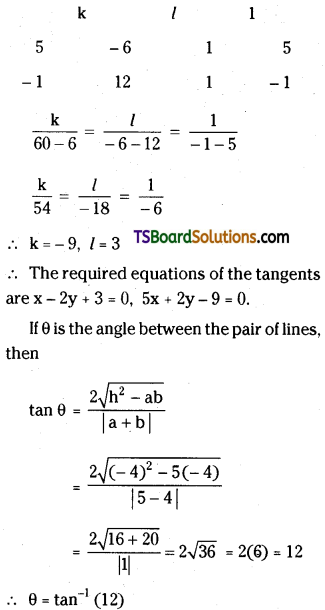
Question 41.
Find the condition for the line lx + my + n = 0 to be a tangent to the ellipse \(\frac{\mathbf{x}^2}{a^2}+\frac{y^2}{b^2}=1\). [(AP) May ’15]
Solution:

Given equation of the ellipse is \(\frac{\mathbf{x}^2}{a^2}+\frac{y^2}{b^2}=1\)
Suppose lx + my + n = 0 ……..(1)
is a tangent to the ellipse \(\frac{\mathbf{x}^2}{a^2}+\frac{y^2}{b^2}=1\)
Let P(x1, y1) be the point of contact.
The equation of the tangent at ‘P’ is S1 = 0
\(\frac{x_1}{a^2}+\frac{y_1}{b^2}-1=0\) ……..(2)
Now (1) & (2) represent the same line.
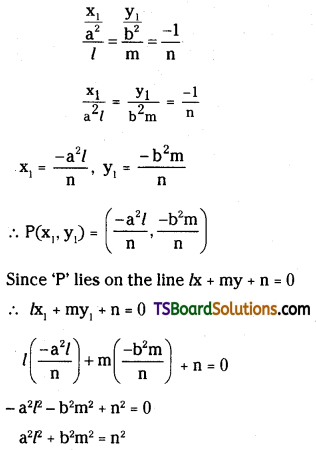

Question 42.
Find the condition for the line lx + my + n = 0 to be normal to the ellipse \(\frac{x^2}{a^2}+\frac{y^2}{b^2}=1\). [Mar. ’01, ’91]
Solution:
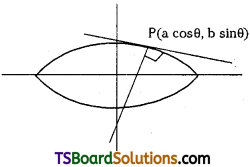
Given the equation of the ellipse is
\(\frac{x^2}{a^2}+\frac{y^2}{b^2}=1\) …….(1)
Suppose lx + my + n = 0 is a normal to the ellipse \(\frac{x^2}{a^2}+\frac{y^2}{b^2}=1\)
Let P(a cos θ, b sin θ) be a point on the ellipse.
∴ The equation of the normal at P(θ) is
\(\frac{a x}{\cos \theta}-\frac{b y}{\sin \theta}=a^2-b^2\) ……..(2)
Now (1) & (2) represent the same line.
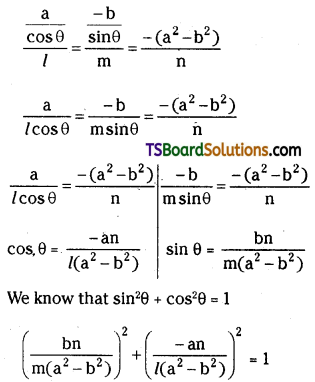
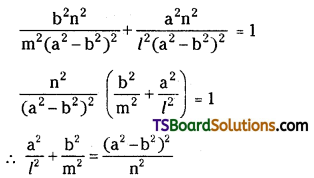
Question 43.
‘C’ is the centre, AA’ and BB’ are the major axis and minor axis of the ellipse \(\frac{x^2}{a^2}+\frac{y^2}{b^2}=1\). If PN is the ordinate of a point P on the ellipse, then show that \(\frac{(P N)^2}{\left(A^{\prime} N\right)(A N)}=\frac{(B C)^2}{(C A)^2}\)
Solution:
Let P(θ) = P(a cos θ, b sin θ) be a point on the ellipse \(\frac{x^2}{a^2}+\frac{y^2}{b^2}=1\)
∴ PN = b sin θ, CN = a cos θ and CA = CA’ = a, CB = CB’ = b
LHS
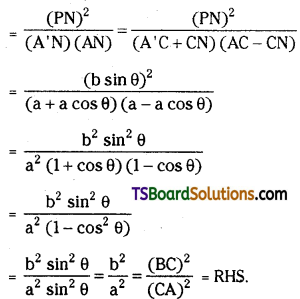
Question 44.
If a tangent to the ellipse \(\frac{x^2}{a^2}+\frac{y^2}{b^2}=1\) (a > b) meets its major axis and minor axis at M and N respectively, then prove that \(\frac{a^2}{(\mathrm{CM})^2}+\frac{b^2}{(\mathrm{CN})^2}=1\) where c is the centre of the ellipse. [(TS) May ’18; (AP) Mar. ’18]
Solution:
Let P(θ) = P (a cos θ, b sin θ)
be a point on the ellipse \(\frac{x^2}{a^2}+\frac{y^2}{b^2}=1\)
The equation of tangent at P(θ) is
\(\frac{x \cos \theta}{a}+\frac{y \sin \theta}{b}=1 \Rightarrow \frac{x}{\left(\frac{a}{\cos \theta}\right)}+\frac{y}{\left(\frac{b}{\sin \theta}\right)}=1\)
It meets the major axis (x-axis) and minor axis (y-axis) at M and N respectively.
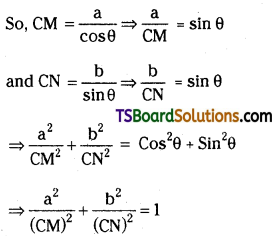
Question 45.
If PN is the ordinate of a point P on the ellipse \(\frac{x^2}{a^2}+\frac{y^2}{b^2}=1\) and the tangent at P meets the x-axis at T, then show that (CN) (CT) = a2 where C is the centre of the ellipse.
Solution:
Given equation of the ellipse is \(\frac{x^2}{a^2}+\frac{y^2}{b^2}=1\)
Let P(θ) = (a cos θ, b sin θ) be a point on the ellipse \(\frac{x^2}{a^2}+\frac{y^2}{b^2}=1\)
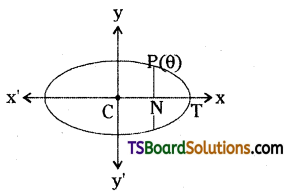
The equation of the tangent at P(θ) is
\(\frac{x}{a} \cos \theta+\frac{y}{b} \sin \theta=1\)
⇒ \(\frac{x}{\frac{a}{\cos \theta}}+\frac{y}{\frac{b}{\sin \theta}}=1\)
This tangent meets the x-axis at T, then x-intercept CT = \(\frac{a}{\cos \theta}\)
The ordinate of P is PN = b sin θ
The absissa of P is CN = a cos θ
LHS = CN . CT
= a cos θ . \(\frac{a}{\cos \theta}\)
= a2
= RHS
∴ CN . CT = a2

Question 46.
Show that the equation of the normal to the ellipse \(\frac{x^2}{a^2}+\frac{y^2}{b^2}=1\) at P(x1, y1) is \(\frac{a^2 x}{x_1}-\frac{b^2 y}{y_1}=a^2-b^2\). (May ’98)
Solution:
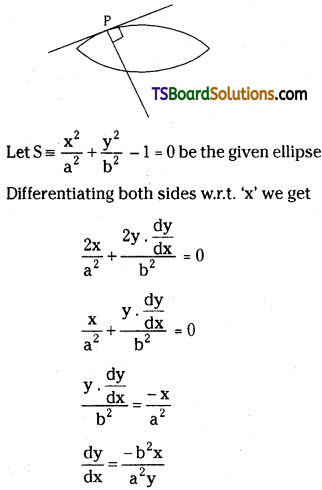
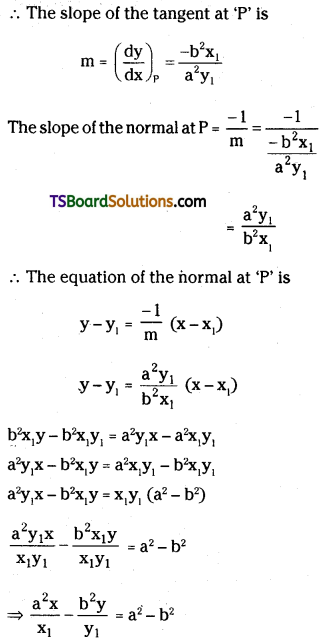
Question 47.
Show that the equation of the tangent at P(θ) on the ellipse S = 0 is \(\frac{x}{a} \cos \theta+\frac{y}{b} \sin \theta=1\). (Mar. ’99)
Solution:

Let the equation of the ellipse be
S = \(\frac{x^2}{a^2}+\frac{y^2}{b^2}-1\) = 0
Given point P = (a cos θ, b sin θ)
The equation of the tangent at ‘P’ is S1 = 0
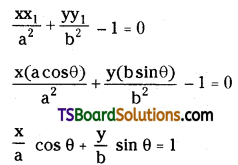
Question 48.
S and T are the foci of an ellipse and B is one end of the minor axis. If STB is an equilateral triangle, then find the eccentricity of the ellipse. [(AP) Mar. ’20]
Solution:
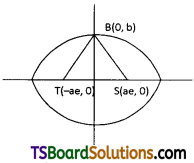
Let \(\frac{x^2}{a^2}+\frac{y^2}{b^2}=1\) (a > b) be an ellipse, whose foci are ‘S’ and ‘T’.
‘B’ is one end of the minor axis such that STB is an equilateral triangle.
Then SB = ST = TB.
We have S = (ae, 0), T = (-ae, 0) and B = (0, b)
Consider SB = ST
⇒ SB2 = ST2
⇒ (ae – 0)2 + (0 – b)2 = (ae + ae)2 + (0 – 0)2
⇒ a2e2 + b2 = (2ae)2
⇒ a2e2 + a2(1 – e2) = 4a2e2
⇒ e2 + (1 – e2) = 4e2
⇒ 4e2 = 1
⇒ e2 = \(\frac{1}{4}\)
⇒ e = \(\frac{1}{2}\)
∴ Eccentricity of the ellipse, e = \(\frac{1}{2}\)
Question 49.
If the ends of the major axis of an ellipse are (5, 0) and (-5, 0). Find the equation of the ellipse in the standard form if its focus lies on the line 3x – 5y – 9 = 0.
Solution:
Let the equation of the ellipse in the standard form is \(\frac{x^2}{a^2}+\frac{y^2}{b^2}=1\) (a > b)
Given that the ends of the major axis of an ellipse are A = (a, 0) = (5, 0)
A’ = (-a, 0) = (-5, 0)
∴ a = 5
Given the equation of the straight line is 3x – 5y – 9 = 0
Focus ‘S’ = (ae, 0)
Since focus ‘S’ (ae, 0) lies on the line 3x – 5y – 9 = 0 then
3(ae) – 5(0) – 9 = 0
⇒ 3ae – 9 = 0
⇒ ae = 3
We know that b2 = a2(1 – e2)
= a2 – a2e2
= 52 – 32
b2 = 16
∴ The equation of the ellipse is \(\frac{x^2}{25}+\frac{y^2}{16}=1\)
⇒ 16x2 + 25y2 = 400

Question 50.
Find the coordinates of the points on the ellipse x2 + 3y2 = 37 at which the normal is parallel to the line 6x – 5y = 2.
Solution:
Given the equation of the ellipse is x2 + 3y2 = 37
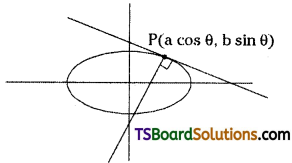
Let P(a cos θ, b sin θ) be a point on the ellipse
The equation of the tangent at P(θ) is
\(\frac{x}{a} \cos \theta+\frac{y}{b} \sin \theta=1\)
The slope of the tangent at P is
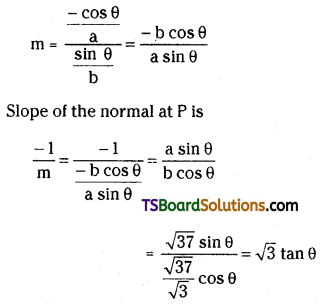
Given the equation of the straight line is 6x – 5y = 2
Slope of the line is m = \(\frac{-6}{-5}=\frac{6}{5}\)
Since the normal is parallel to the line 6x – 5y = 2, the slopes are equal.
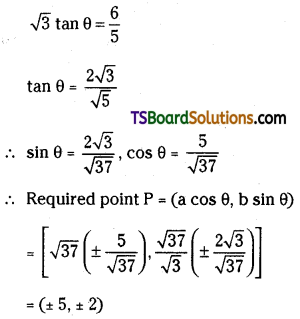
Since tan θ is positive, then P = (5, 2), (-5, -2).
![]()
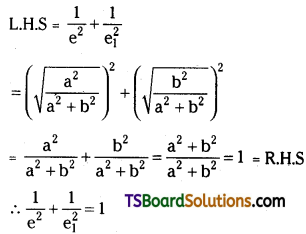
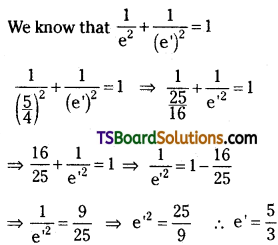
![]()
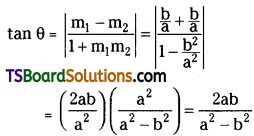
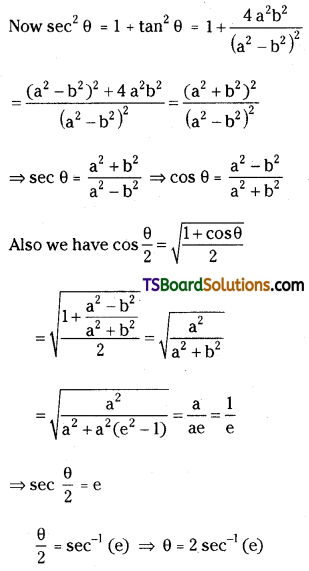


![]()
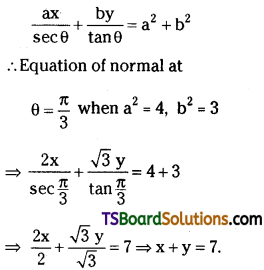
![]()
